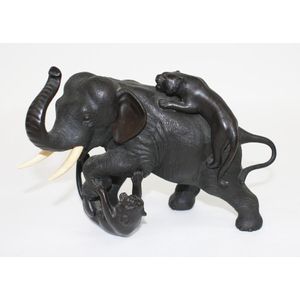Iridescent Qing Dynasty Ox Sculpture
A brown Iridescent glazed Muscular ox, Qing Dynasty 18/19th century, realistically modelled with hooves & tail picked out in black, length 20, height 12 cm
You must be a subscriber, and be logged in to view price and dealer details.
Subscribe Now to view actual auction price for this item
When you subscribe, you have the option of setting the currency in which to display prices to $Au, $US, $NZ or Stg.
This item has been sold, and the description, image and price are for reference purposes only.
- Ming Dynasty - The Ming Dynasty was a ruling dynasty of China from 1368 to 1644. It succeeded the Yuan Dynasty and preceded the Qing Dynasty. The Ming Dynasty was established by Zhu Yuanzhang, a former Buddhist monk who became a rebel leader and eventually overthrew the Mongol Yuan Dynasty. During the Ming Dynasty, China experienced a period of relative stability and prosperity. The government was centralized and bureaucratic, with the emperor at the top of the hierarchy. The Ming Dynasty is known for its cultural achievements, including the development of porcelain, the invention of movable type printing, and the construction of the Great Wall of China.
- Iridescent Decoration of Porcelain - Iridescent decoration of porcelain is a technique in which a thin layer of metallic glaze is applied to the surface of porcelain to create a shimmering, rainbow-like effect. The metallic glaze is usually made with a mixture of metal oxides, such as gold, silver, or platinum, that are fused to the surface of the porcelain during firing.
This technique was first developed in the late 19th century, and was particularly popular in Art Nouveau and Art Deco styles of decorative art. Iridescent decoration of porcelain can create a wide range of colours and patterns, depending on the types of metal oxides used and the firing techniques employed. It is a highly skilled and labour-intensive process, requiring a great deal of technical expertise and attention to detail. Today, iridescent porcelain remains a popular and highly valued form of decorative art. - Qing Dynasty - The Qing Dynasty was the last imperial dynasty of China, ruling from 1644 to 1912. It was established by the Manchu people, who originated from the northeastern region of China. The Qing Dynasty was preceded by the Ming Dynasty and followed by the Republic of China.
Visually similar items

Meiji period (1868-1912), Japanese bronze model of two tigers attacking an elephant, with inset ivory tusks, signed. Length 24 cm
Sold by
in
for
You can display prices in $Au, $US, $NZ or Stg.

A carved Indian ivory figure of an elephant. Height 10 cm
Sold by
in
for
You can display prices in $Au, $US, $NZ or Stg.

A spelter statuette of an elephant, modeled standing. Length 36.5 cm
Sold by
in
for
You can display prices in $Au, $US, $NZ or Stg.

An old Chinese bronze small model of a shishi, engraved details, scrolling tail. Length 7 cm
Sold by
in
for
You can display prices in $Au, $US, $NZ or Stg.
